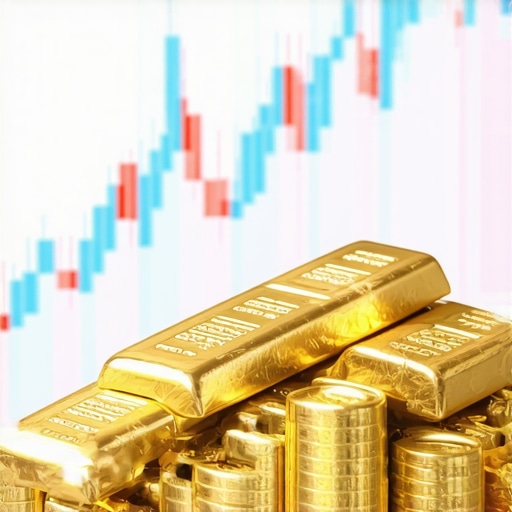The Crucial Role of Supply and Demand in Shaping Gold’s Future Market Trajectory
In the realm of advanced investment strategies, understanding the intricate supply and demand mechanisms of gold is paramount. As global economic landscapes evolve, the interplay between these fundamental forces will significantly influence gold prices, offering both challenges and opportunities for seasoned investors aiming to optimize their portfolios for 2025 and beyond. This analysis not only explores the core dynamics but also integrates macroeconomic factors, geopolitical influences, and technological advancements that are redefining gold’s market fundamentals.
Unveiling the Complexities of Gold’s Market Supply Chain
What are the emerging factors impacting gold mine production and central bank reserves?
Gold supply is primarily driven by mine production, recycling, and central bank reserves. However, recent trends reveal that geopolitical tensions, environmental policies, and technological innovations in mining are reshaping these traditional sources. For instance, the increasing central bank gold purchases, as detailed in this comprehensive report, indicate a strategic shift towards reserve diversification amid geopolitical uncertainties.
Demand Drivers: From Jewelry to Institutional Investments
How are emerging consumer behaviors and institutional strategies influencing global gold demand?
Demand for gold spans various sectors, including jewelry, technology, and institutional investment. Notably, the surge in gold-backed ETFs and mutual funds reflects a maturation of investment channels, providing liquidity and diversification opportunities. Meanwhile, the jewelry industry continues to be a vital demand segment, yet shifts towards ethical sourcing and sustainability are influencing consumer preferences. For detailed insights, see this guide.
Market Dynamics and Future Price Predictions
Considering the supply-demand equilibrium, macroeconomic variables such as inflation rates, currency fluctuations, and geopolitical stability are critical. According to market forecasts, gold prices are poised for volatility but exhibit bullish trends driven by inflation hedging and increased central bank reserves. Investors must analyze these indicators holistically to formulate resilient strategies.
How can investors leverage gold demand-supply insights to optimize their 2025 portfolios?
Strategic portfolio diversification, including gold ETFs, physical assets, and mining stocks, can mitigate risks associated with market volatility. For expert guidance, explore best gold investment types. Continuous monitoring of geopolitical developments and macroeconomic indicators will be essential for making informed decisions.
For a deeper understanding of how market trends influence gold prices, consider reviewing top demand trends. Stay engaged with industry insights and contribute your expertise to the evolving discourse on gold’s strategic role in wealth preservation.
Deciphering the Hidden Currents: How Do Global Economic Shifts Reshape Gold’s Demand?
As we venture further into 2025, understanding the nuanced forces driving gold demand becomes crucial for sophisticated investors. Beyond mere supply and demand stats, macroeconomic shifts such as inflation trajectories, currency valuations, and geopolitical stability are subtly influencing gold’s appeal across sectors. For instance, the rise in emerging markets’ middle classes has amplified jewelry demand, while geopolitical tensions have spurred institutional investment in gold reserves. According to a recent analysis by the market experts, these factors are converging to create a resilient environment for gold as a safe haven asset.
What Are the Psychological and Cultural Drivers Behind Gold’s Enduring Popularity?
While economic indicators are vital, understanding the psychological and cultural underpinnings of gold demand reveals deeper insights. Gold symbolizes wealth, security, and status across many societies, making it a preferred investment during times of uncertainty. The resurgence of gold in digital assets like blockchain-backed tokens also indicates a blending of tradition with innovation, appealing to a broader demographic. Experts suggest that these cultural narratives significantly impact demand, especially in regions like Asia and the Middle East, where gold holds profound cultural significance. For a comprehensive view, see this industry report.
Can Advanced Data Analytics Improve Gold Market Predictions?
In the era of big data, investors are increasingly leveraging analytics to forecast market trends with greater accuracy. Techniques such as machine learning models analyze vast datasets—covering macroeconomic indicators, geopolitical news, and market sentiment—to predict gold price movements more reliably. These tools can identify subtle patterns often missed by traditional analysis, providing a strategic edge. According to a recent publication by the financial analytics firm, integrating data-driven strategies into gold investing can significantly enhance portfolio resilience against volatility.
How can investors incorporate behavioral finance principles to make smarter gold investment decisions in 2025?
Behavioral finance emphasizes the importance of understanding psychological biases and market sentiment. Recognizing herd behavior, overconfidence, and loss aversion can help investors avoid pitfalls and capitalize on opportunities. For instance, during market dips, contrarian strategies rooted in behavioral insights often yield superior results. To deepen your understanding, explore this guide on sophisticated investment tactics. Engaging with community forums and expert analyses also provides valuable perspectives on market sentiment and emerging trends, allowing for more nuanced decision-making.
Stay proactive and curious—sharing your insights or asking questions about gold demand trends can foster a more informed investment community. For further reading, consider examining how geopolitical developments influence gold markets or how technological innovations in mining might alter supply dynamics in the future.
Decoding the Influence of Geopolitical Tensions and Technological Innovations on Gold Supply Chains
As we delve deeper into the complexities of gold supply, it becomes evident that geopolitical developments and technological advancements are catalysts for significant shifts in production and reserves. For example, recent sanctions on major gold-producing nations have disrupted traditional supply routes, forcing industry stakeholders to adapt swiftly. Moreover, innovations like automation and environmentally sustainable mining techniques are not only reducing costs but also expanding the feasible extraction zones, thereby influencing overall supply dynamics. According to a report by the World Gold Council, these technological strides are expected to elevate global mine output by approximately 2-3% annually through 2025, despite geopolitical uncertainties.
Emerging Consumer Preferences and Institutional Strategies Reshaping Global Gold Demand
The landscape of gold demand is continuously evolving, driven by shifts in consumer behavior and institutional investment strategies. Notably, the rise of ethical sourcing and sustainability concerns has led to a surge in demand for responsibly mined gold, influencing supply chain transparency and certification standards. Simultaneously, institutional investors are increasingly favoring gold-backed financial instruments, such as ETFs and digital tokens, as safe-haven assets amidst economic volatility. This diversification in demand channels underscores a sophisticated investor base that seeks liquidity, security, and ethical credentials. For an in-depth understanding, see this comprehensive analysis by the World Gold Council.
How Do Macroeconomic Variables and Geopolitical Stability Interact to Influence Gold’s Future Price Trajectory?
Analyzing gold’s future prices necessitates a nuanced understanding of macroeconomic and geopolitical factors. Inflation rates, currency stability, and global political tensions act as primary drivers, often interacting in complex ways. For instance, rising inflation and currency devaluations tend to bolster gold as an inflation hedge, while geopolitical conflicts heighten its status as a safe haven. According to Bloomberg’s forecast, these interconnected forces suggest a bullish outlook for gold in 2025, though with periods of heightened volatility that require strategic agility. Investors should consider macroeconomic indicator trends alongside geopolitical developments to refine their investment approaches.
What strategic methodologies can investors employ to leverage supply and demand insights for optimal portfolio management in 2025?
Advanced portfolio strategies involve integrating gold ETFs, physical holdings, and mining equities to hedge against diverse risks. Employing quantitative models that incorporate real-time macroeconomic and geopolitical data can provide predictive insights, allowing investors to preempt market shifts. Additionally, behavioral finance principles—such as recognizing herd behavior and market sentiment—are crucial for timing entry and exit points. For instance, contrarian investing during market overreactions can yield substantial gains. To further refine your approach, explore these expert strategies for gold investment in 2025. Continuous learning and engagement with industry updates will ensure your strategies remain resilient amid market fluctuations.
Engagement with complex market models and deep analysis of supply-demand fundamentals will be pivotal for seasoned investors aiming to capitalize on gold’s potential as a resilient asset class. Stay informed, adapt proactively, and contribute your insights to foster a richer understanding of this dynamic market landscape.
Emerging Technological Innovations and Their Impact on Gold Extraction Efficiency
Technological advancements, such as automation, AI-driven exploration, and environmentally sustainable mining practices, are revolutionizing gold production. These innovations not only reduce operational costs but also expand the feasible extraction zones, thereby potentially increasing global supply. According to the World Gold Council, these developments could elevate annual mine output by approximately 2-3% through 2025, despite geopolitical uncertainties, altering supply-demand balances significantly.
How Are Cultural Narratives and Digital Transformation Reshaping Gold’s Demand Landscape?
Gold’s enduring appeal is deeply rooted in its cultural significance and evolving digital presence. In regions like Asia and the Middle East, gold symbolizes wealth and security, reinforcing its demand during economic and political upheavals. Meanwhile, the emergence of blockchain-backed tokens and digital gold assets introduces a new paradigm, blending traditional value with technological innovation. These shifts are fostering broader acceptance among younger demographics and tech-savvy investors, which could reshape demand patterns profoundly.
What Are the Cutting-Edge Analytical Techniques Enhancing Gold Market Forecasting?
Big data and machine learning are transforming gold market predictions by analyzing vast datasets encompassing macroeconomic indicators, geopolitical events, and market sentiment. These sophisticated models can identify subtle market shifts and provide more reliable forecasts than traditional methods. A recent report by a leading financial analytics firm highlights how incorporating these tools enhances investment resilience and timing precision.
How can investors harness behavioral finance principles to optimize gold investments in 2025?
Understanding behavioral biases like herd mentality, overconfidence, and loss aversion is essential for making rational decisions amid market volatility. Contrarian strategies, especially during market overreactions, can yield substantial gains. Resources such as this comprehensive guide provide actionable insights into integrating behavioral finance into portfolio management, fostering a disciplined, informed approach.
Engage actively with emerging research, participate in expert discussions, and continuously refine your strategies to stay ahead in the dynamic gold market landscape of 2025.
Assessing the Interplay Between Macroeconomic Variables and Geopolitical Risks on Gold Pricing
The interplay between inflation trajectories, currency stability, and geopolitical tensions creates a complex environment that influences gold’s price trajectory. Rising inflation and currency devaluations tend to bolster gold as a hedge, while geopolitical conflicts heighten its safe-haven appeal. Bloomberg’s 2024 forecast underscores a bullish outlook, emphasizing the need for investors to monitor macroeconomic data and geopolitical developments closely.
What Strategic Approaches Enable Investors to Leverage Supply-Demand Dynamics Effectively?
Advanced portfolio strategies involve diversification across gold ETFs, physical assets, and mining equities, complemented by real-time data analytics. Quantitative models incorporating macroeconomic and geopolitical indicators facilitate anticipatory decision-making. Behavioral finance insights further aid in timing market entries and exits, especially during periods of market overreaction. For detailed strategies, explore these expert recommendations tailored for 2025. Staying informed about technological innovations and geopolitical shifts is vital for maintaining a resilient investment stance.
Expert Insights & Advanced Considerations
Innovative Supply Chain Technologies
Emerging innovations such as AI-driven exploration and automation are revolutionizing gold extraction, increasing efficiency and potentially boosting global supply by 2-3% annually through 2025, as highlighted by the World Gold Council. Staying informed on technological trends is crucial for strategic investors.
Geopolitical Impact on Reserves
Geopolitical tensions continue to influence central bank gold reserve strategies, with increased diversification efforts and strategic gold purchases shaping market dynamics. Monitoring international relations provides valuable foresight for long-term portfolio planning.
Behavioral Finance and Market Sentiment
Understanding herd behavior, overconfidence, and loss aversion helps investors navigate volatility. Incorporating behavioral insights can improve timing and decision-making, especially during market overreactions or downturns.
Digital Transformation and Cultural Narratives
The rise of blockchain-backed tokens and digital gold assets is expanding gold’s appeal among younger, tech-savvy investors, blending tradition with innovation. Recognizing cultural significance in regions like Asia and the Middle East remains vital for accurate demand forecasting.
Data Analytics and Predictive Modeling
Leveraging machine learning and big data analytics enhances market predictions, allowing for more precise timing and risk management. Integrating these tools into investment strategies provides a competitive edge in volatile environments.
Curated Expert Resources
- World Gold Council: Offers comprehensive reports on technological innovations, supply chain shifts, and demand trends, essential for advanced analysis.
- Bloomberg: Provides macroeconomic and geopolitical forecasts that influence gold price trajectories, critical for strategic planning.
- Investopedia: Features expert articles on behavioral finance and trading strategies, useful for refining investment tactics.
- Financial Analytics Firms: Specialized in machine learning models and big data analysis, supporting data-driven decision-making in gold investments.
- Industry Think Tanks: Focused on digital transformation and cultural influences, providing nuanced insights into evolving demand patterns.
Final Expert Perspective
In 2025, understanding advanced supply chain innovations, geopolitical strategies, and behavioral finance principles is essential for mastering gold market dynamics. The integration of data analytics and technological advancements offers unmatched opportunities for strategic positioning. Engage deeply with authoritative sources, contribute your insights, and stay proactive in adapting to market shifts. For those committed to excellence, continuous learning and strategic agility will be the hallmarks of success in this evolving landscape. To deepen your expertise, explore how gold dealers influence market trends in 2025 and stay ahead of the curve.










This post provides a comprehensive overview of the complex factors influencing gold’s future market trajectory. I appreciate the emphasis on how geopolitical tensions and technological innovations are reshaping supply chains—these are often overlooked in classic demand-supply analyses. From my experience, staying updated on central bank activities and technological trends can give investors an edge, especially as new extraction methods and digital assets become more prevalent. I’m curious, how do you see the balance between physical gold and digital gold assets evolving over the next few years? Do you think digital tokens will increasingly become a major driver of demand, particularly among younger investors? I believe understanding these shifts could be key for both diversifying and future-proofing investment portfolios amidst ongoing economic uncertainties.